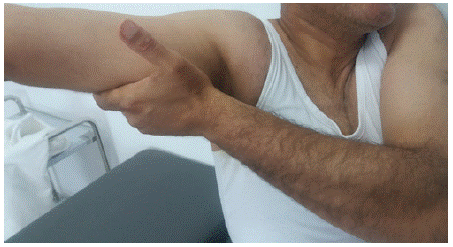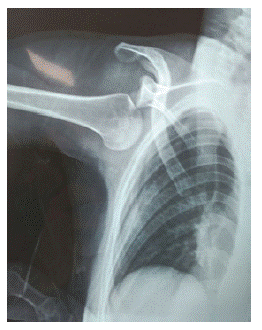
Clinical Image
Austin Emerg Med. 2022; 8(2): 1083.
Shoulder Erecta Dislocation
Zaizi A*, Rachdi A and Boussouga M
Department of Orthopaedic Surgery & Traumatology II, Mohamed V Military Hospital, Faculty of Medicine and Pharmacy, Mohamed V University, Morocco
*Corresponding author: Abderrahim Zaizi, Doctor at Department of Orthopaedic Surgery & Traumatology II, Mohamed V Military Hospital, Faculty of Medicine and Pharmacy, Mohamed V University, Rabat 10100, Morocco
Received: October 08, 2022; Accepted: November 02, 2022; Published: November 09, 2022
Clinical Image
Dislocation of the shoulder is defined by a total loss of contact of the humeral head with the glenoid socket of the scapula. Inferior shoulder dislocation or luxatio erecta humeri is a rare type of glenohumeral dislocation that constitutes <1% of all shoulder dislocations, characterized by subglenoid displacement of the humeral head [1]. Irreducible abduction is pathognomonic attitude for shoulder erecta dislocation.It is a traumatological emergency, that should be early recognized and reduced to prevent neurovascular compromise with increased swelling [2].
We report a case of right should ererecta dislocation in a 40-years-old patient occurring during a fall in the stairs with arm abducted. The patient was admitted to the emergency department with an attitude of irreducible abduction of his right shoulder, the neurovascular examination was normal (Figure 1). The right shoulder X-ray imaging showed inferior displacement of the right humeral head under the glenoid fossa referring to aluxation erecta humeri without associated fracture. (Figure 2). Therefore, patient underwent emergent orthopedic reduction under sedation and elbow immobilization to the body for three weeks then physiotherapy. The follow-up showed a stable, pain-free, mobile and active shoulder.

Figure 1: Irreducible attitude of right shoulder in abduction.

Figure 2: Anteroposterior X-rays demonstrating dislocation of the humeral
head inferiorly in relation to the glenoid fossa.
Conflict of Interest
The authors declare that they have no competing interests.
References